Industrial Machine Vision Lenses Market Research, 2032
The global industrial machine vision lenses market size was valued at $7.1 billion in 2022 and is projected to reach $19.9 billion by 2032, growing at a CAGR of 11.4% from 2023 to 2032. Industrial lenses generally refer to fixed magnification lenses, variable magnification lenses, telecentric lenses, etc. used in industrial production. Industrial lenses are critical components in machine vision systems because they have a direct impact on the implementation of system algorithms and image effects. Scratch and damage detection of metal materials, glass, film, wafers, and other surface layers, MARK point positioning, glue dispenser, SMT detection, precision parts size measurement, industrial microscopic vision alignment, label digital high-speed comparison detection, electronic components shape defects and dimensions, detection of circuit board lines and jack positions, detection of injection liquid volume, printing batch number are all applications for industrial lenses.
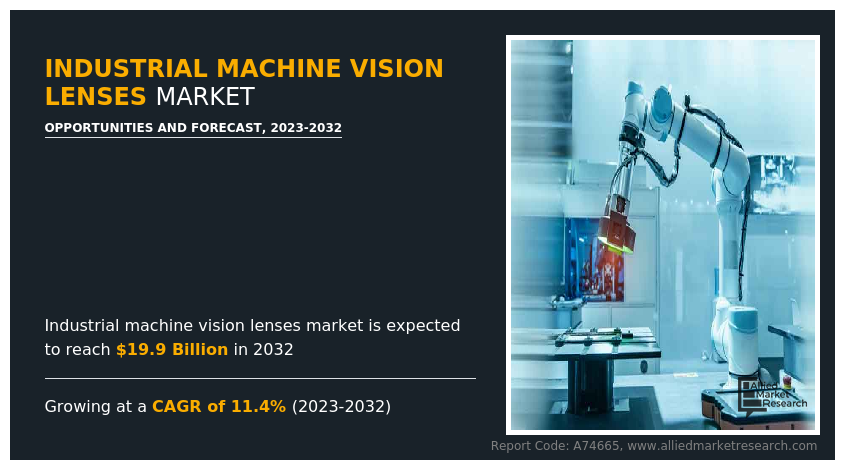
Rising demand for quality inspection and control in the manufacturing sector is predicted to drive the industrial machine vision lenses market growth. Machine vision technology plays a crucial role in enhancing production efficiency, reducing errors, and ensuring product quality in various manufacturing processes. Industrial machine vision lenses are essential components of machine vision systems used in manufacturing industries. These lenses capture high-resolution images and transmit them to vision systems for analysis and inspection. They enable automated visual inspection processes by providing clear and accurate images of the products or components being inspected.
Technical issues and breakdowns in machine vision systems can prove incredibly disruptive to businesses. Companies need a dedicated in-house team to monitor and evaluate their machine vision systems. This team needs to conduct regular and unplanned maintenance and update and change algorithms as required. Testing changes can be a long and time-intensive process. These factors are anticipated to restrain the industrial machine vision lenses market.
The industry players are investing a lot of effort in the research and development of smart and unique strategies to sustain their growth in the market. These strategies include product launches, mergers & acquisitions, collaborations, partnerships, and refurbishing of existing technology. The M117FM-RG Compact 29mm Machine-Vision Lens Series was launched by Tamron. In many areas, especially with attention to the body’s compact size, a significant improvement was made. The M117FM-RG series is thus suitable for use in robotics and other complex applications. The M117FM-RG series is appropriate for use cases where strong contrast is required yet there is a space restriction. The lenses can be fitted practically anywhere because there is no performance degradation from the center to the edges and because the outside diameter is just about 29mm. The M117FM-RG series’ anti-vibration and shock performance is improved over earlier models because of its redesigned tough mechanical construction. The novel system limits optical (image) deflection to 10 m and suppresses the effects of vibration and shock up to 10G in magnitude. These factors are predicted to drive the industrial machine vision lenses market opportunity.
The industrial machine vision lenses market outlook is segmented based on type, camera, application, end user, and region. By type, the market is sub-segmented into C-mount, CS-mount, F-mount, S-mount, and others. By camera, the market is classified into line scan cameras and area scan cameras. By application, the market is classified into measurement and identification. By end user, the market is classified into automotive, electronics & semiconductor, pharmaceutical & chemical, logistics, agriculture, food industries, and others. By region, the market is analyzed across North America, Europe, Asia-Pacific, and LAMEA.
Segment Overview
The industrial machine vision lenses market is segmented into Type, Camera, Application, and End User.
By type, the C-mount sub-segment dominated the market in 2022. The C-mount lens is a specific type of lens mount that has gained popularity and widespread adoption in the machine vision industry due to its versatility and compatibility with various camera systems. The C-mount lens is designed to be easily interchangeable between different camera systems. It has a standardized thread size and distance from the image sensor, making it compatible with a wide range of machine vision cameras. This flexibility allows manufacturers to use C-mount lenses with different cameras without the need for significant modifications or additional equipment. These are predicted to be the major factors affecting the industrial machine vision lenses market forecast period.
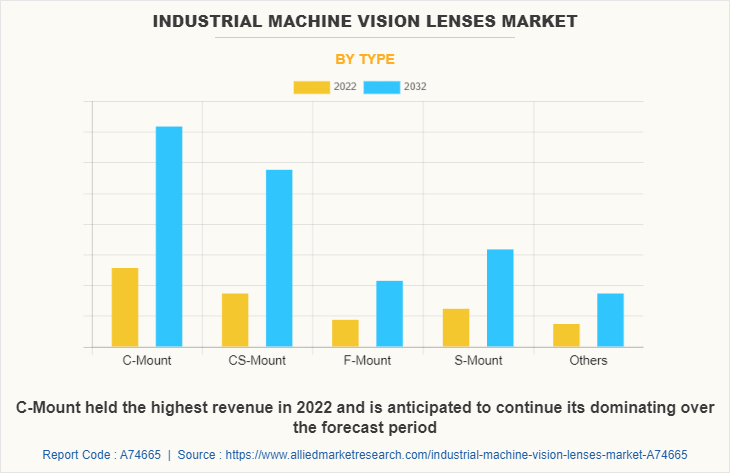
By camera, the area scan camera sub-segment dominated the global industrial machine vision lenses market share in 2022. Area scan cameras, also known as 2D cameras, are widely used in machine vision systems for capturing static images of an entire scene or a specific area. These cameras play a crucial role in industrial inspection and quality control processes, and they significantly influence the demand for machine vision lenses. There is a greater demand for high-quality lenses that can capture sharp and clear images. Machine vision lenses are specifically developed to fulfill the needs of machine vision applications, such as optimizing picture quality, minimizing distortion, and delivering exact focus. These lenses are frequently employed to improve image quality, and depth of field, or to achieve specified magnification levels. These numerous applications that the area scan camera can be used in are predicted to drive the sub-segment. The availability of lenses compatible with different sensor sizes of area scan cameras drives the demand for the machine vision camera lens.
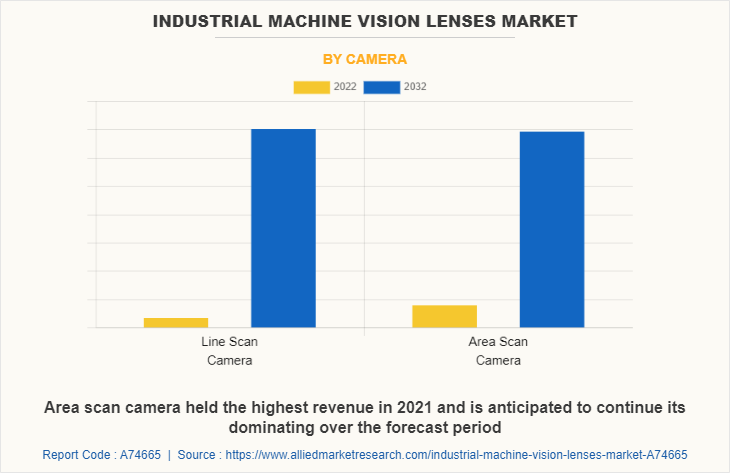
By application, the identification sub-segment dominated the global industrial machine vision lenses market share in 2022. Machine vision technology plays a crucial role in identification processes across industries, including manufacturing, logistics, automotive, pharmaceuticals, and more. Machine vision systems, equipped with high-quality lenses, enable reliable and accurate identification of objects, products, components, barcodes, labels, and characters. Optical Character Recognition (OCR) technology is employed for the automatic recognition and reading of characters or text. Machine vision systems with OCR capabilities are utilized for tasks such as reading product labels, identifying part numbers, verifying serial numbers, and extracting information from documents. Industrial machine vision zoom lenses that provide clear image quality, high resolution, and low distortion are essential for accurate OCR processing, driving the demand for such lenses in the market.
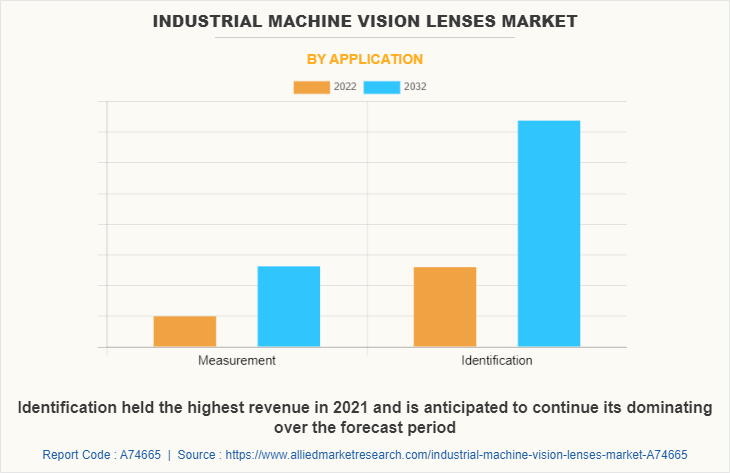
By end user, the electronics & semiconductor sub-segment dominated the global industrial machine vision lenses market share in 2022. Machine vision lenses are used in the electrical and semiconductor industries for a variety of tasks including quality assurance, inspection, and process automation. Cameras and lenses are used by machine vision systems to take pictures of semiconductor devices, circuit boards, and electronic components for analysis and measurement. The electronic and semiconductor industry relies heavily on machine vision technology for inspection, quality control, and process optimization throughout the manufacturing process. As a result, there is a growing demand for high-performance machine vision lenses tailored to the specific requirements of the electronic and semiconductor industry.
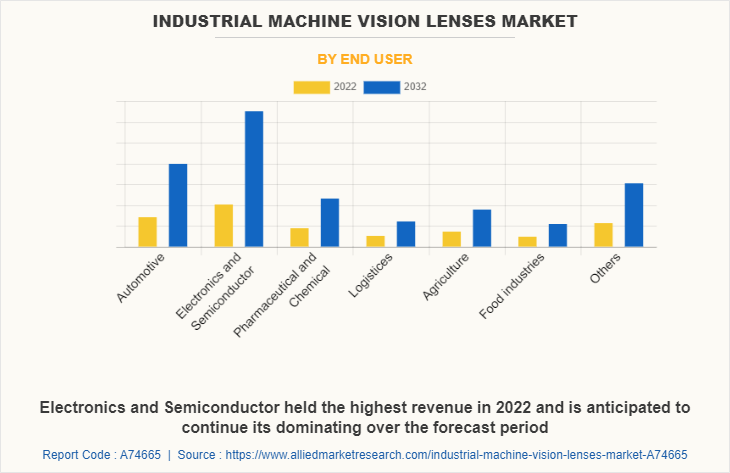
By region, Asia-Pacific dominated the global market in 2022. The Asia-Pacific region has the highest number of manufacturing plants in the world. The increased acceptance of robots and the significant usage of AI, ML, and big data organizations in nations like China, Japan, and South Korea are the main reasons why the need for machine vision systems in the Asia-Pacific region is predicted to increase. The increasing development and implementation of machine vision systems in countries such as China, Japan, and Indonesia are the primary drivers of the market in this Asia-Pacific. The thriving automotive and semiconductor sectors in China and Japan will further contribute to Asia-Pacific market growth. China, Japan, India, Indonesia, Malaysia, and South Korea have emerged as the prominent countries in the Asia-Pacific region market, with the automotive, electronics, and semiconductor sectors accounting for the majority of sales. Expansion initiatives launched in these countries contribute to market growth in these countries as well.
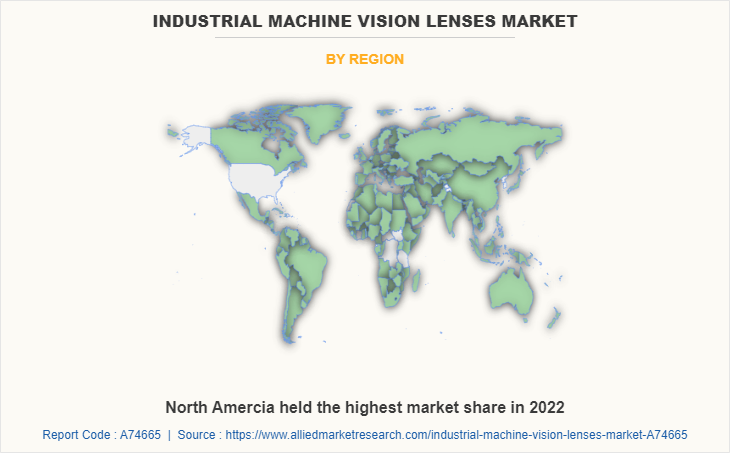
Key Benefits For Stakeholders
- This report provides a quantitative analysis of the market segments, current trends, estimations, and dynamics of the industrial machine vision lenses market analysis from 2022 to 2032 to identify the prevailing industrial machine vision lenses market opportunities.
- The market research is offered along with information related to key drivers, restraints, and opportunities.
- Porter's five forces analysis highlights the potency of buyers and suppliers to enable stakeholders to make profit-oriented business decisions and strengthen their supplier-buyer network.
- An in-depth analysis of the industrial machine vision lenses market segmentation assists in determining the prevailing market opportunities.
- Major countries in each region are mapped according to their revenue contribution to the global market.
- Market player positioning facilitates benchmarking and provides a clear understanding of the present position of the market players.
- The report includes an analysis of the regional as well as global industrial machine vision lenses market trends, key players, market segments, application areas, and market growth strategies.
Industrial Machine Vision Lenses Market Report Highlights
| Aspects | Details |
| Market Size By 2032 | USD 19.9 billion |
| Growth Rate | CAGR of 11.4% |
| Forecast period | 2022 - 2032 |
| Report Pages | 320 |
| By Type |
|
| By Camera |
|
| By Application |
|
| By End User |
|
| By Region |
|
| Key Market Players | Moritex, Kenko Tokina Co, Computar (CBC Group), Schneider, Ricoh, Kowa Lenses, Myutron Inc, Nikon, VST, Fujifilm |
Advancements in machine vision technology, including higher resolution cameras, improved image sensors, and enhanced optical systems, have contributed to the growth of the industrial machine vision lenses market. These developments enable better image quality, higher accuracy, and increased inspection speed, further driving the demand for machine vision lenses in manufacturing.
The major growth strategies adopted by industrial machine vision lenses market players are investment and agreement.
Asia-Pacific will provide more business opportunities for the global industrial machine vision lenses market in future.
Kowa Lenses, Myutron Inc, Computar (CBC Group), Nikon, Ricoh, Fujifilm, Schneider, Moritex, Kenko Tokina Co, and VST are the major players in the industrial machine vision lenses market.
The report provides an extensive qualitative and quantitative analysis of the current trends and future estimations of the global industrial machine vision lenses from 2022 to 2032 to determine the prevailing opportunities.
Loading Table Of Content...
Loading Research Methodology...



